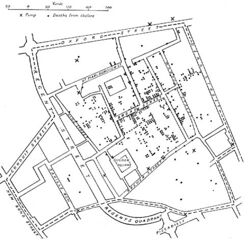Endemic (nonfiction): Difference between revisions
Jump to navigation
Jump to search
No edit summary |
No edit summary |
||
| Line 1: | Line 1: | ||
In epidemiology, an infection is said to be '''endemic''' (from Greek ἐν ''en'' "in, within" and δῆμος ''demos'' "people") in a population when that infection is maintained in the population without the need for external inputs. | [[File:London_cholera_map_1854.jpg|250px|thumb|Original map by John Snow showing the clusters of cholera cases in the London epidemic of 1854.]]In epidemiology, an infection is said to be '''endemic''' (from Greek ἐν ''en'' "in, within" and δῆμος ''demos'' "people") in a population when that infection is maintained in the population without the need for external inputs. | ||
For example, chickenpox is endemic (steady state) in the UK, but malaria is not. | For example, chickenpox is endemic (steady state) in the UK, but malaria is not. | ||
Latest revision as of 12:24, 24 June 2016
In epidemiology, an infection is said to be endemic (from Greek ἐν en "in, within" and δῆμος demos "people") in a population when that infection is maintained in the population without the need for external inputs.
For example, chickenpox is endemic (steady state) in the UK, but malaria is not.
Every year, there are a few cases of malaria reported in the UK, but these do not lead to sustained transmission in the population due to the lack of a suitable vector (mosquitoes of the genus Anopheles).
In the News
Fiction cross-reference
Nonfiction cross-reference
External links:
- Endemic @ Wikipedia
